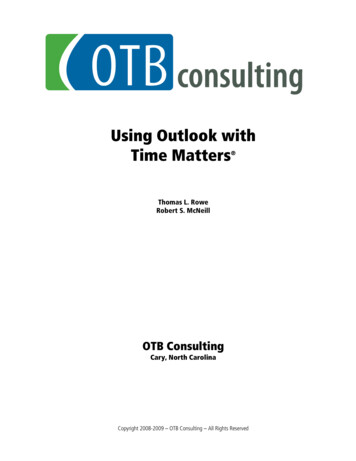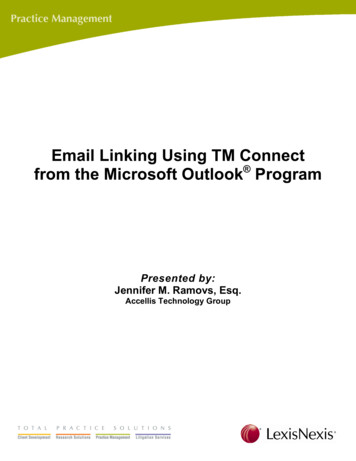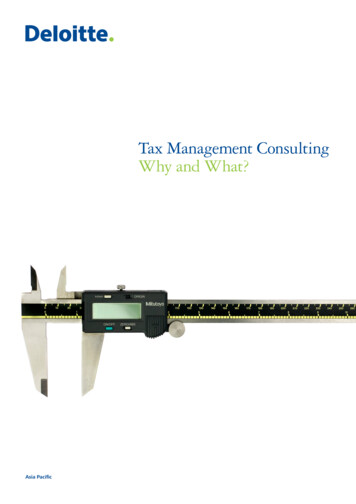
Transcription
2017 MANAGEMENTCONSULTING OUTLOOKSTAY CONNECTEDgreentarget.cominfo@greentarget.com
ContentsOverview .2Key Trends and Implications . 2State of the Consulting Industry .3The U.S. Market. 3Hot Industries and Services . 4Big-Name Players Take a Big Piece of the Pie . 5Sharing the Leftovers: Niche Companies Shake Up Industry . 5Sprinting to Growth: The Fastest-Growing Firms. 6An Eye Toward the Future: Consulting in 2017 .7Growth but Uncertainty: Consulting Under the Trump Administration . 8Shapeshifting: The Changing Consulting Landscape . 10Disrupters: Drawing New Lines . 10Online Consulting . 11New Governance Models. 12Changing Business Models: From Traditional to Digital . 13M&A: Redrawing Market Distribution . 15Consulting or Marketing? Blurred Lines . 15A New Differentiator? Industry Standards . 16Growth Projections: Industries Ripe for Consulting . 17Healthcare . 17Financial Services and Fintech . 17Digital, IoT and Cybersecurity . 18Supporting the Industry: Labor Streams . 20Conclusion . 231
OverviewIn a time of economic and political uncertainty, the outlook for consulting services is bright. This reportprovides an overview of the state of the market and offers a snapshot of key growth areas and trendsshaping the industry. The findings signal notable shifts driven by the proliferation of digital technologies,the emergence of niche boutique firms and independent consultants, and fierce competition for talent.Key Trends and ImplicationsDespite slowdown in 2016, opportunities abundant amid government shakeup: Though 2016 waseconomically and politically volatile, as government intentions become clearer several markets will seesignificant disruption – driving demand for consulting services.Outlook positive but growth not guaranteed: The coming year could either be a boon – withskyrocketing growth fueled by the upheaval of critical industries – or a bust if policy and legislativechanges are stalled. Regardless, the traditional drivers of risks and opportunities will likely continue tosupport demand for consulting services.Many markets slated for change: Despite uncertainty about any final outcomes, several criticalindustries are slated for regulatory and policy changes under the new administration. Most industriesexpect a more favorable environment, but several challenges are likely to arise. Consultants would bewise to keep an eye on industries most at risk of change – healthcare, financial services, energy,manufacturing, retail, technology and defense.Big-name players dominate, but small players carving out strongholds: The bigwigs – including the BigFour and large firms like McKinsey – continue to command a significant market share, but small firmsare shaking things up by carving out strongholds in niche markets with specialized services. The fastestgrowing firms (both small and big) are seeing triple-digit growth.Disruptors shaking up market dynamics: Freelance and network-based models are redrawing industrylines with the help of more knowledgeable buyers, pushing traditional consulting firms to explore newbusiness models and forcing more collaboration in the market.Proliferation of digital-driving new business models: Having finely tuned their tools, managementconsulting firms are moving away from an overreliance on experienced consultants to incorporate moretechnology-based solutions and business models. They are leveraging technologies that automateconsulting capabilities and embracing digital for both front- and back-end operations.Flow of industry’s lifeblood slowing as talent pool dries up: The market is in a tight battle for talentwith a shrinking (but diversifying) talent pool and the rise of independent consultants. Smaller firms aregaining traction in retaining talent but continue to face competition from the bigger stalwart firms.Firms are adjusting their recruitment processes and turning to more direct hiring.2
State of the Consulting IndustryThe global management consulting market is worth an estimated 130 billion. Operations consultingholds the lion’s share of the market, at an estimated 70 billion, followed by HR consulting and strategyconsulting, which each have 30 billion markets. Companies continue to seek services, with theirmanagement consulting expenditures growing approximately 4 percent annually over the past fewyears. Although the market is headed for what ALM Intelligence calls “a decelerating trajectory,”abundant opportunities remain, including those generated by the current political environment andexpanded focus areas such as cybersecurity.Source: Consultancy.ukThe U.S. MarketThe U.S. holds a staggering 93 percent share of the total North American consultancy market and isbetween five and 10 times larger than the U.K. and German markets. As the most mature market, theU.S. leads in its offerings and innovation and is home to the headquarters of three of the Big Four –Deloitte, EY and PwC – as well as several other large consultancies, such as McKinsey and Bain. The U.S.market grew 7.7 percent in 2015 to reach 54.7 billion, up from 50.8 billion in 2014. Although 2016data hasn’t yet been published, the growth trend was expected to continue, with the U.S. accounting fornearly half (44 percent) of the global market.Source: Consultancy.uk3
Hot Industries and ServicesHealthcare continues to be an important growth engine in the North American market. However, if theeconomic growth rate remains below the 2 percent level, ALM Intelligence predicts additional publicspending derived from the public sector and aerospace and defense industry could boost consultingrevenues as well.The U.S. market was led by digital and technology consulting – the fastest-growing and largest segment,worth 14.4 billion. Growth in digital was fueled by unwavering demand for offerings such as digitaltransformation, e-commerce and the Internet of Things (IoT). Notably, digital is the only segmentexpected to experience double-digit growth through 2018. The second-largest segment was risk andregulatory consulting, which reached 14 billion amid cybersecurity concerns – a 7.8 percent increaseover 2014.The biggest sector in 2015 was financial services, which spent 13.5 billion – a 9 percent increase over2014. Retail experienced the largest growth in consultancy services, growing 11 percent to nearly 4billion as retailers upped their digital investments to keep pace with e-commerce and omnichanneldemands. Demand from the public sector grew slightly to take a 6 billion piece of the overall market.Energy and resources took another significant piece, growing by 5 percent to 7.3 billion. Thepharmaceutical sector also experienced notable growth (10 percent) to take up a 1.7 billion chunk ofthe consultancy pie amid increasing public pressure.Source: Consultancy.ukAlthough 2016 started off on a positive note, the full-year outlook wasn’t as optimistic due to anxietyresulting from an unstable economic and political landscape. Client confidence was shaken, and mixedeconomic signals were putting investors on edge. Edward Haigh of Source Global Research saidconsultants “didn’t feel quite as bullish as they did in 2015, citing client hesitation in the face of growing4
global and domestic uncertainty. Still, they do feel that ongoing digital disruption and other rapid-firechanges happening in the U.S. market will drive plenty of work in 2017.Big-Name Players Take a Big Piece of the PieThe Big Four – Deloitte, EY, KPMG and PwC – command an 11 percent share of the market, representing 19.6 billion. In the U.S., they have secured about 35 percent of the market. In the U.K., the Big Four aregrowing five times faster than the wider consulting market. In 2015 in the U.K., this group grew by 11.5percent, well ahead of the 8.2 percent growth experienced by the industry as a whole. Their growth isborne primarily out of an aggressive train of acquisitions. Together, the four completed more than 35deals in 2015. They have also invested heavily in consulting, encroaching on territory traditionallydominated by firms such as McKinsey and Bain. Fiona Czerniawska, director and founder of SourceGlobal Research, attributes the Big Four’s growth to client recognition of “the scale and scope they canbring to bear” as well as inorganic growth.One substantial growth area for the Big Four is HR consulting – revenue in this area grew between 5 and10 percent in 2014. Though some of the growth was attributed to inorganic strategies, it's noteworthythat the Big Four have succeeded in improving service delivery by integrated HR offerings from adjacentbusiness lines such as strategy, tax and transactions consulting. They’ve also been key innovators in thespace. The Big Four is “leading in the design of new HR operating models, the practical application ofdata analytics across all manner of HR engagements and more,” said Liz DeVito, associate director, leadfor HR Consulting Research for KCRA.Forbes’ list of America’s Best Management Consulting Firms points to Deloitte, McKinsey, PwC and BCGas the leading firms. The list is based on two surveys – one of partners and project managers frommanagement consultancies and the other of management consultancy clients – across 15 industries and16 functional areas, including strategy, HR and supply chain management. The leading firms wererecommended in every functional area with the exception of executive search. KPMG and PwC’sStrategy& scored in every functional area except sustainability. Accenture, Deloitte, McKinsey, PwC andBCG earned recommendations in each industry sector, while EY scored in all but aerospace and defense,and IBM scored in all but oil and gas; KPMG met the mark in all but automotive.These well-established and well-known firms are maintaining a stronghold on the market at a time whenreputation and stakeholders’ perceptions of an organization are increasingly viewed as strategic assets.This is evident by Deloitte’s acquisition of U.K. consulting firm Regester Larkin, well-known for its crisis,reputation and issues management.Sharing the Leftovers: Niche Companies Shake Up IndustrySmall firms are breaking ground both in terms of firm management and financial performance –disrupting the market from the ground up. Growth among small firms has been attributed to highlyspecialized firms that can carve out strongholds in niche markets. For example, in the M&A advisoryspace, the large-scale strategy, audit and consulting firms can use their brands to secure a significantportion of the market. However, the shifting landscape is reducing the advantages of traditional groups,and new consulting models by the likes of Global PMI Partners and Eden McCallum are transforminghow the best projects are resourced from strategy to technology consulting. Highly specialized M&A5
boutiques are chipping away to secure their own stronghold in the market. “A few small consultanciesspecializing in M&A are increasingly winning work with private equity and corporate clients who arelooking for a better alternative,” writes Global PMI Partners’ Andrew Scola.Notably, research by a master’s student at Lund University suggests small firms (or boutique firms) areoften staffed by senior and experienced consultants, which is a critical component in attracting andretaining clients. The research also indicates that boutique firms are better able to offer a personalizedprocess because they can secure more involvement from the client on the advisory process. “Theinternal bureaucracies and communication policies within large consultancies create barriers on therelationship with the client that are prejudicial for an efficient partnership,” the author writes. “Thesmaller dimensions of the boutique firm and the almost non-existence of communication barriersfacilitates the working relationship between consultants and clients.”The seven firms on Consulting magazine’s 2017 list of Seven Small Jewels saw revenue of 45 percent in2016 – 3 percentage points higher than in 2015. Though the firms differ, a common theme is playing outas each small player has carved out its own niche to take on the big-name players. This year’s jewelsinclude: Atlas Executive Consulting: The San Diego company’s revenue grew 209 percent as it secured astronghold in the federal market via “laser focus on quality control.” CorpInfo: The company, based in Santa Monica, California, saw growth jump from 26.1 millionin 2015 to 34.6 million in 2016 by establishing a foothold in the aerospace, retail and utilitiesmarkets with an IT focus. Enovation Partners: The Chicago-based company’s revenue grew 100 percent in 2016 as itcarved out a space in the energy consulting market with a focus on innovation. Evans Incorporated: With revenue jumping from 7 million in 2014 to 11 million in 2016, thecompany set itself apart from competitors with its unique offerings in aviation. Impact Makers: The company, with revenues of 22.4 million in 2016, differentiates itself byoffering clients a way to deliver community value by contributing 100 percent of its net profitsto charities. Strativity Group: Armed with 13.5 million in revenue, the company positions itself as aresponse to failed CRM projects that lacked the strategic and operational muscle to succeed. Toffler Associates: With a focus on the disruption business and helping clients in the ThirdWave, or “knowledge era,” the company generated revenue of 16.8 million in 2016.All in all, the signs indicate that small firms can expect growth if they can capitalize on niche segmentsand hone in on the weaknesses of large firms. As we’ll see throughout this report, significant growth ispossible with the right mix of experience, specialization and personalized service.Sprinting to Growth: The Fastest-Growing FirmsThe fastest-growing firms are experiencing triple-digit growth, which reflects the opportunities availablein the market. Consulting magazine’s list of the fastest-growing firms in 2016 paints a picture of howfirms are adjusting their business models and zeroing in on high-growth areas.6
Boutique management consulting firm RedCloud Consulting was dubbed the fastest-growingfirm with a 526 percent growth rate, which managing partner Brett Alston attributed to thefirm’s focus on accountability, dependability and results. Alston said the success isn’t driven bya reinvention of the wheel, but a return to the origins of the industry based on an approach inwhich all stakeholders are fully informed and work together. Runner-up CoreCompete saw growth of 513 percent over the past three years due to what itcalls “small, expert and nimble delivery teams” that help companies navigate the big datatransition. The company also pointed to increased interest in big data and referrals fromexisting customers. Second runner-up L4 Digital grew 487 percent by leveraging a multi-platform experience andpartnering with brands. “Our expansion of partnerships this year engaged our company across awide range of platforms and devices ranging from connected TVs to game consoles andwearables,” explained Principal and Co-Founder Keith O’Neill. “By increasing our knowledgebase, L4 has been able to provide services to new and current customers that remain at theforefront of technology.” Fourth-place Novus Global Solutions fueled a 445 percent growth rate by transitioningconsulting jobs away from offshore companies back onshore. Using a unique, localizedconsulting delivery model in several countries, the company provides advisory services to the Csuite.These success stories demonstrate that growth is possible if firms adapt their business models inresponse to the changing environment and take advantage of opportunities presented by increaseddisruption.An Eye Toward the Future: Consulting in2017The outlook for the consulting industry in 2017 is bright, according to Consulting magazine, as acombination of economic momentum and a pro-business administration converges with the upheaval ofcritical industries and support for increased infrastructure spending. But no forecast is guaranteed, anda number of factors could put a grinding halt to any projected growth, be it global unrest, internationalthreats or inflation. Regardless, consulting executives seem more confident than they did after whatmany are calling an “outstanding year,” which saw some firms surpass 20 percent growth. Indeed, in2016, 94 percent of executives said they experienced real revenue growth, though only 91 percent hadexpected to. Markedly, nearly two-thirds said growth surpassed 10 percent.Consulting magazine’s Executive Outlook survey suggests that the majority of firms (98 percent) expectgrowth, with 91 percent projecting more than 6 percent. Specifically, 66 percent of firms expect theirrevenue to grow by 10 percent or more in 2017, while a quarter expect growth between 6 and 9percent. In terms of profit, 80 percent of firm executives reported improvements in 2016, and asignificant 96 percent anticipate improved profits in 2017. Importantly, only 1 percent of executives saidthey expect profits to fall this year, and only 3 percent expect no change in profits.7
Growth but Uncertainty: Consulting Under the TrumpAdministrationThere are three possibilities for consulting firms in the uncertain political environment. On the onehand, 2017 could see skyrocketed demand as companies adjust to new policies and legislative changes.On the other, the year could be a bust if policy and legislative actions stall. The third option, and themost likely, is that the same drivers of risk and opportunity seen in 2016 will continue to drive demandfor consulting services. The possibility of disruptions adding to the existing drivers of change will dependwholly on the extent to which President Trump is able to make his policy intentions materialize.The administration has signaled its desire to deregulate industry and make changes to infrastructurespending and trade and immigration laws. If successful, these changes would have significant impacts onan array of industries, from financial services to healthcare“In the consulting market, disruptionand the public sector. Specific policy changes, such as thealways means there is anrepeal of the Affordable Care Act (ACA), would impactopportunity. We need to hone in oncertain businesses, such as health insurers. At the samethe right areas of disruption andtime, policy changes, such as corporate tax reform, couldareas where we can make adrive increased demand for specific consulting services (e.g.,difference and add value for ourtax advisory services).clients.”The Trump administration’s impact on the consultingSrikant Sastry, Grant Thornton nationalindustry depends on several factors, including the potentialmanagement principal of advisory servicesreplacement of the ACA, the degree of infrastructureinvestment, the range of deregulation and tax rule reformand the degree of trade policy changes and their bearing on specific industries. “Based on our analysis ofpolicies proposed to date by the administration and Congress, we believe there will be a business uptickin 2017 resulting from deregulation early in the year followed by tax reform and infrastructurespending,” said Gary Sturisky, managing partner, consulting, RSM. Janet Foutty, chairman and CEO ofDeloitte, reminds us that the key competencies of consulting firms will remain pertinent regardless ofthe Trump administration. “Policy changes could present new opportunities, but the core work businessleaders do every day – optimizing talent, driving innovation, determining where to invest, focusing oncustomers, driving growth – remains a priority regardless of who is president.”Most industries, especially financial services and oil and gas, are anticipating a more favorableregulatory environment. However, consulting executives told Consulting magazine that several industrychallenges are likely to arise based on President Trump’s rhetoric throughout the election.1. Healthcare: Though it’s far from clear what will happen to the ACA, its repeal would significantlyimpact providers, payers and small businesses across industries. Corporate tax cuts could helpinsurers, while pharmaceutical companies grapple with mounting pricing pressure.2. Public sector: The new administration is expected to slash the federal workforce while shiftingpriorities for certain agencies and departments and pushing for more collaboration between theprivate and public spheres. At the state level, public agencies are expected to take on moreauthority.8
3. Financial services: Cuts to regulations borne out of the 2008 financial crisis (e.g., Dodd-Frank)are expected, leading financial services firms to take on more risks and new growthopportunities. Lending revenues may grow with the help of interest rate hikes.4. Energy: Environmental regulations and standards for fossil fuels are on the chopping block – apositive signal for oil and gas companies and their suppliers.5. Manufacturing: Greater emphasis on domestic job growth in the manufacturing industry willpresent opportunities and challenges, particularly regarding the placement of product facilitiesand job creation. These changes will pair with the ongoing technology-driven transformation ofthe manufacturing industry.6. Retail: Expected changes don’t bode well for retailers. The implementation of new trade tariffscould adversely impact retailers that manufacture significant portions of their products outsidethe U.S. Large retailers could be forced to remap their entire supply chain, close stores andimplement cost-cutting measures.7. Technology: Restrictions on immigration will create talent management issues for technologycompanies, but it’s not all bad news. Large companies could benefit from a tax break forrepatriating overseas profits, while smaller companies and startups take advantage of a morefavorable IPO market borne out of loosened public company regulations, decreased taxes andfreed-up capital.8. Defense: Rollbacks of defense spending cuts implemented in 2013 could drive growth for thedefense industry and its suppliers, though the president has sent mixed signals to contractors,particularly regarding costs.Consulting firms with expertise in these areas are ripe for growth as demand increases, but they’re notalone. Second-tier and regional accounting and consulting firms could benefit markedly in anenvironment favorable to small businesses. “If Obamacare and other regulations are scaled back, I seesmall businesses hiring and really trying to grow,” explained Rich Iler, COO of NorthPoint Group.Regardless of the policy changes, however, companies will continue to face the same disruptors. “Theglobal trends of the past few years – the move to digital, machine learning, analytics, cybersecurity andother trends we’re all familiar with – are going to continue. The genie is out of the bottle, so to speak,and we’re all trying to figure out how to best respond to these trends. I don’t see those areas beingaffected by the political changes that have occurred,” said Srikant Sastry, Grant Thornton nationalmanagement principal of advisory services. Irrespective of who is in the Oval Office, critical businessfunctions (e.g., talent recruitment, investment decisions, innovation) will remain top priorities.A safe option for 2017 is increasing investment and interest in digital transformation, new technologies,data analytics and cybersecurity. Several other areas are also poised for growth, though forecasts arerockier and rely on favorable policy and legislation development unfolding.1. Tax and compliance: Tax reform and trade tariffs, coupled with recent developments ininternational fiscal, government and tax policy, would make tax planning more important andcould lead multinationals to restructure their tax planning strategies.2. Growth strategy: In recent years, growth has been fueled by acquisitions made more favorableby low interest rates. In the evolving landscape, companies are likely to need a hand developingstrategies for more organic growth.9
3. Supply chain: New tariffs on imports will force U.S. manufacturers to draft new sourcingstrategies and secure new sourcing partners.Shapeshifting: The Changing ConsultingLandscapeThere are several critical macro factors contributing to disruption in the consulting market, according toEx-Consultants Agency, including:1. Smart buyers: Clients are building out their own corporate strategy teams, staffed with formerconsultants, making them more sophisticated buyers.2. Lower cost competitors: New entrants such as curated networks and freelancers are enteringthe market and offering clients reduced fees with comparable talent to the big consultant firms.3. Penetration of technology: Technology is making its mark as a core capability within consultingmodels.4. Consolidation of mature players: Large firms are acquiring mid-size strategy companies toprovide a full suite of services, making it increasingly difficult for mid-size players to compete ina market where scale benefits matter.Disrupters: Drawing New LinesBorne out of the cutbacks spurred by the 2002 and 2008 recessions, and the entrepreneurial essence ofthe dot-com economy, increasing numbers of independent consultants have entered the market.Although these freelance consultants initially posed little threat to the dominating market leaders,digital networking has provided them with the needed muscle to establish a marketplace for theirservices. As Nathan Simon and Michael Taylor explain in Consulting magazine, the development ofcoordinated networks of freelancers helps circumvent constraints of scalability by consolidating businessdevelopment activities and standardizing elements of project structuring and management. Freelancemodels offer consultants flexibility and freedom from business development while offering clients moreon-demand service at lower costs.Network-based consulting firms are redrawing industry lines with the help of savvy buyers – consultantsthat left the industry during recessive periods and took up positions in industry. In parallel, the market isseeing a shift toward what LexisNexis refers to as “uberization,” under which services become morecommoditized and transactional. These shifts are driving consulting firms to leverage more flexibleorganizational structures and use more freelance and transactional arrangements, rather than long-termpartnerships.At the same time, a drive toward value-based pricing arrangements is playing out as savvy buyers lookto realize economic value from consulting efforts. These buyers have the upper hand in thesetransactions as competition in the market increases. Increasingly, they are seeking better control overproviders in order to help them better manage their expenses and secure high-quality services.Procurement managers may implement performance tracking metrics to measure suppliers’10
performance against agreed-upon contract terms. However, Simon and Taylor point out thatperformance-based free structures aren’t aggressively promoted by consultants in strategy and otherareas that don’t align well with discrete outcomes. Clients have also complained that thesearrangements end up costing them more than traditional fee structures.Online ConsultingThese new lines are pushing market leaders to explore new business models. A surge in on-demandconsulting has led to the emergence of a new delivery model in which consulting services are offered viaonline platforms. Both new entrants and traditional consulting firms are launching crowdsourci
management consultancies and the other of management consultancy clients – across 15 industries and 16 functional areas, including strategy, HR and supply chain management. The leading firms were recommended in every functional area with the exception of executive search. KPMG and Pws










